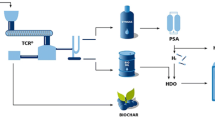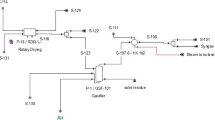Abstract
Coffee residues (CRs) were gasified using a laboratory-scale fluidized bed gasifier with an air/steam mixture as the carrier gas. The gasification was conducted at an equivalence ratio (ER) of 0.3, and different operation temperatures (700, 800, and 900 °C) and steam-to-biomass (S/B) ratios (0, 0.75, and 1.5) were applied. Increasing temperature without steam boosted H2 and CO concentrations in producer gas, raising lower heating value (LHV) and cold gas efficiency (CGE) through endothermic reactions like Boudouard, tar cracking, and water-gas formation. At 900 °C, gas had LHV of 3.76 MJ/Nm3 and CGE of 22.47%. It was elevating temperature from 700 to 900 °C and S/B ratio to 1.5 raised H2 and CO concentrations from 2.04 to 8.60% and from 9.56 to 11.8%, respectively. This also increased LHV from 2.23 to 3.89 MJ/Nm3 and CGE from 11.28 to 25.08%. The steam gasification reaction was found to increase the H2 concentration and was thus considered effective in converting CRs to syngas and increasing energy production. Overall, the study successfully demonstrated the feasibility of steam gasification as a means of converting coffee residues to syngas and increasing energy production. The results also highlighted the importance of operating temperature and S/B ratio in improving the gasification process.






Similar content being viewed by others
Data availability
All data generated or analyzed during this study are included in this published article.
References
Adegoke KA, Akinnawo SO, Ajala OA, Adebusuyi TA, Maxakato NW, Bello OS (2022) Progress and challenges in batch and optimization studies on the adsorptive removal of heavy metals using modified biomass-based adsorbents. Bioresour Technol Rep 101115. https://doi.org/10.1016/j.biteb.2022.101115
Aristizábal-Marulanda V, Solarte-Toro JC, Cardona Alzate CA (2021) Study of biorefineries based on experimental data: production of bioethanol, biogas, syngas, and electricity using coffee-cut stems as raw material. Environ Sci Pollut Res 28:24590–24604. https://doi.org/10.1007/s11356-020-09804-y
Bijoy G, Rajeev R, Benny L, Jose S, Varghese A (2022) Enzyme immobilization on biomass-derived carbon materials as a sustainable approach towards environmental applications. Chemosphere 135759. https://doi.org/10.1016/j.chemosphere.2022.135759
Cay H, Duman G, Yanik J (2019) Two-step gasification of biochar for hydrogen-rich gas production: effect of the biochar type and catalyst. Energy Fuels 33:7398–7405. https://doi.org/10.1021/acs.energyfuels.9b01354
Chen YH, Ngo TNLT, Chiang KY (2021) Enhanced hydrogen production in co-gasification of sewage sludge and industrial wastewater sludge by a pilot scale fluidized bed gasifier. Int J Hydrogen Energy 46:14083–14095. https://doi.org/10.1016/j.ijhydene.2020.10.081
Chiang KY, Chien KL, Lu CH (2012) Hydrogen energy production from disposable chopsticks by a low temperature catalytic gasification. Int J Hydrogen Energy 37:15672–15680. https://doi.org/10.1016/j.ijhydene.2012.06.030
Chiang KY, Lin YX, Lu CH, Chien KL, Lin MH, Wu CC, Ton SS, Chen JL (2013) Gasification of rice straw in an updraft gasifier using water purification sludge containing Fe/Mn as a catalyst. Int J Hydrogen Energy 38:12318–12324. https://doi.org/10.1016/j.ijhydene.2013.07.041
Chiang KY, Lin MH, Lu CH, Chien KL, Lin YH (2015) Improving the synthesis gas quality in catalytic gasification of rice straw by an integrated hot-gas cleaning system. Int J Green Energy 12:1005–1011. https://doi.org/10.1080/15435075.2013.871635
Chiang KY, Lu CH, Liao CK, Ger RHR (2016) Characteristics of hydrogen energy yield by co-gasified of sewage sludge and paper-mill sludge in a commercial scale plant. Int. J. Hydrogen Energy 41:21641–21648. https://doi.org/10.1016/j.ijhydene.2016.06.199
Chiang KY, Liao CK, Lu CH (2016) The effects of prepared iron-based catalyst on the energy yield in gasification of rice straw. Int J Hydrogen Energy 41:21747–21754. https://doi.org/10.1016/j.ijhydene.2016.08.021
Chou WL, Wang CT, Huang KY, Chang YC, Shu CM (2012) Investigation of indium ions removal from aqueous solutions using spent coffee grounds. Int J Phys Sci 7:2445–2454. https://doi.org/10.5897/IJPS12.192
Cortazar M, Santamaria L, Lopez G, Alvarez J, Zhang L, Wang R, Olazar M (2023) A comprehensive review of primary strategies for tar removal in biomass gasification. Energy Conver Manag 276:116496. https://doi.org/10.1016/j.enconman.2022.116496
Da Silva JCG, Alves JLF, Mumbach GD, Andersen SLF, Moreira RDFPM, Jose HJ (2023) Hydrogen-rich syngas production from steam gasification of Brazilian agroindustrial wastes in fixed bed reactor: kinetics, energy, and gas composition. Biomass Convers Biorefin 1-24. https://doi.org/10.1007/s13399-023-04585-z
De Andres JM, Narros A, Rodríguez ME (2011) Behaviour of dolomite, olivine and alumina as primary catalysts in air–steam gasification of sewage sludge. Fuel 90:521–527. https://doi.org/10.1016/j.fuel.2010.09.043
Evaristo RB, Ferreira R, Rodrigues JP, Rodrigues JS, Ghesti GF, Silveira EA, Costa M (2021) Multiparameter-analysis of CO2/Steam-enhanced gasification and pyrolysis for syngas and biochar production from low-cost feedstock. Energy Conver Manag X 12:100138. https://doi.org/10.1016/j.ecmx.2021.100138
Fremaux S, Beheshti SM, Ghassemi H, Shahsavan-Markadeh R (2015) An experimental study on hydrogen-rich gas production via steam gasification of biomass in a research-scale fluidized bed. Energy Conv Manag 91:427–432. https://doi.org/10.1016/j.enconman.2014.12.048
Garcia-Freites S, Welfle A, Lea-Langton A, Gilbert P, Thornley P (2020) The potential of coffee stems gasification to provide bioenergy for coffee farms: a case study in the Colombian coffee sector. Biomass Convers Biorefin 10:1137–1152. https://doi.org/10.1007/s13399-019-00480-8
Gupta R, Pandit C, Pandit S, Gupta PK, Lahiri D, Agarwal D, Pandey S (2022) Potential and future prospects of biochar-based materials and their applications in removal of organic contaminants from industrial wastewater. J Mater Cycles Waste Manag 24:852–876. https://doi.org/10.1007/s42773-019-00006-5
International Coffee Organization (2020) World Coffee Statistics Database. https://icocoffee.org/what-we-do/world-coffee-statistics-database/
Joseph L, Jun BM, Flora JR, Park CM, Yoon Y (2019) Removal of heavy metals from water sources in the develo** world using low-cost materials: a review. Chemosphere 229:142–159. https://doi.org/10.1016/j.chemosphere.2019.04.198
Karatas H, Akgun F (2018) Experimental results of gasification of walnut shell and pistachio shell in a bubbling fluidized bed gasifier under air and steam atmospheres. Fuel 214:285–292. https://doi.org/10.1016/j.fuel.2017.10.061
Kibret HA, Kuo YL, Ke TY, Tseng YH (2021) Gasification of spent coffee grounds in a semi-fluidized bed reactor using steam and CO2 gasification medium. J. Taiwan Inst Chem Eng 119:115–127. https://doi.org/10.1016/j.jtice.2021.01.029
Kong D, Luo K, Wang S, Yu J, Fan J (2022) Particle behaviours of biomass gasification in a bubbling fluidized bed. Chem Eng J 428:131847. https://doi.org/10.1016/j.cej.2021.131847
Lakshmi D, Akhil D, Kartik A, Gopinath KP, Arun J, Bhatnagar A, Muthusamy G (2021) Artificial intelligence (AI) applications in adsorption of heavy metals using modified biochar. Sci Total Environ 801:149623. https://doi.org/10.1016/j.scitotenv.2021.149623
Lay CH, Dharmaraja J, Shobana S, Arvindnarayan S, Priya RK, Saratlae R, Kumar G (2022) Lignocellulose biohydrogen towards net zero emission: a review on recent developments. Bioresource Technol 364:128084. https://doi.org/10.1016/j.biortech.2022.128084
Ling JLJ, Go ES, Park YK, Lee SH (2022) Recent advances of hybrid solar-biomass thermo-chemical conversion systems. Chemosphere 290:133245. https://doi.org/10.1016/j.chemosphere.2021.133245
Ma Y, Ge Z, Zeng M, Zha Z, Tao Y, Zhang H (2023) Reactivity and performance of steam gasification during biomass batch feeding. Carbon Resour Convers 6:229–237. https://doi.org/10.1016/j.crcon.2023.03.001
Maged A, Dissanayake PD, Yang X, Pathirannahalage C, Bhatnagar A, Ok YS (2021) New mechanistic insight into rapid adsorption of pharmaceuticals from water utilizing activated biochar. Environ Res 202:111693. https://doi.org/10.1016/j.envres.2021.111693
Nandhini R, Berslin D, Sivaprakash B, Rajamohan N, Vo DVN (2022) Thermochemical conversion of municipal solid waste into energy and hydrogen: a review. Environ Chem Lett 20:1645–1669. https://doi.org/10.1007/s10311-022-01410-3
Nguyen VT, Chiang KY (2022) Sewage and textile sludge co-gasification using a lab-scale fluidized bed gasifier. Int J Hydrogen Energy 47(96):40613–40627. https://doi.org/10.1016/j.ijhydene.2021.08.191
Pandey B, Sheth PN, Prajapati YK (2022) Tar cracking enhancement by air sparger installation in the combustion zone of the downdraft gasifier. Biomass Bioenergy 166:106620. https://doi.org/10.1016/j.biombioe.2022.106620
Prabu S, Chiang KY (2023) Ni-based nanoparticle catalyst for enhancing hydrogen production in coffee residue gasification and applying carbon deposits catalyst in electrochemical energy storage. Surf Interfaces 38:102859. https://doi.org/10.1016/j.surfin.2023.102859
Roche E, de Andrés JM, Narros A, Rodríguez ME (2014) Air and air-steam gasification of sewage sludge. The influence of dolomite and throughput in tar production and composition. Fuel 115:54–61. https://doi.org/10.1016/j.fuel.2013.07.003
Rodrigues JP, Ghesti GF, Silveira EA, Lamas GC, Ferreira R, Costa M (2022) Waste-to-hydrogen via CO2/steam-enhanced gasification of spent coffee ground. Cleaner Chem Eng 4:100082. https://doi.org/10.1016/j.clce.2022.100082
Sazali SN, Al-attab KA, Zainal ZA (2019) Gasification enhancement and tar reduction using air fogging system in a double walled downdraft biomass gasifier. Energy 186:115901. https://doi.org/10.1016/j.energy.2019.115901
Schmid M, Beirow M, Schweitzer D, Waizmann G, Spörl R, Scheffknecht G (2018) Product gas composition for steam-oxygen fluidized bed gasification of dried sewage sludge, straw pellets and wood pellets and the influence of limestone as bed material. Biomass Bioenergy 117:71–77. https://doi.org/10.1016/j.biombioe.2018.07.011
Song T, Wu J, Shen L, **ao J (2012) Experimental investigation on hydrogen production from biomass gasification in interconnected fluidized beds. Biomass Bioenergy 36:258–267. https://doi.org/10.1016/j.biombioe.2011.10.021
Susilayati M, Marwoto P, Priatmoko S (2022) Characterization of spent coffee grounds in the community as supporting materials for renewable energy. Jurnal Penelitian Pendidikan IPA 8:918–924. https://doi.org/10.29303/jppipa.v8i2.1227
Tiwari SK, Bystrzejewski M, De Adhikari A, Huczko A, Wang N (2022) Methods for the conversion of biomass waste into value-added carbon nanomaterials: recent progress and applications. Prog Energy Combust Sci 92:101023. https://doi.org/10.1016/j.pecs.2022.101023
Vikram S, Deore SP, De Blasio C, Mahajani SM, Kumar S (2023) Air gasification of high-ash solid waste in a pilot-scale downdraft gasifier: experimental and numerical analysis. Energy 270:126912. https://doi.org/10.1016/j.energy.2023.126912
Wan Z, Yang S, Hu J, Bao G, Wang H (2022) Numerical analysis of wood air gasification in a bubbling fluidized gasifier with reactive charcoal as bed material. Renew Energy 188:282–298. https://doi.org/10.1016/j.renene.2022.01.094
Wilson L, John GR, Mhilu CF, Yang W, Blasiak W (2010) Coffee husks gasification using high temperature air/steam agent. Fuel Process Technol 91:1330–1337. https://doi.org/10.1016/j.fuproc.2010.05.003
Zachl A, Buchmayr M, Gruber J, Anca-Couce A, Scharler R, Hochenauer C (2022) Evaluation and extension of the load and fuel flexibility limits of a stratified downdraft gasifier. Energy 239:122279. https://doi.org/10.1016/j.Energy2021.122279
Zeng J, ** gasification. Biomass Bioenergy 104:1–7. https://doi.org/10.1016/j.biombioe.2017.03.020
Zhang L, Xu CC, Champagne P (2010) Overview of recent advances in thermo-chemical conversion of biomass. Energy Convers Manag 51:969–982. https://doi.org/10.1016/j.enconman.2009.11.038
Zhang J, Wang M, Xu S, Feng Y (2019) Hydrogen and methane mixture from biomass gasification coupled with catalytic tar reforming, methanation and adsorption enhanced reforming. Fuel Process Technol 192:147–153. https://doi.org/10.1016/j.fuproc.2019.04.023
Zhang R, Zhang J, Guo W, Wu Z, Wang Z, Yang B (2021) Effect of torrefaction pretreatment on biomass chemical loo** gasification (BCLG) characteristics: gaseous products distribution and kinetic analysis. Energy Convers Manag 237:114100. https://doi.org/10.1016/j.enconman.2021.114100
Zhou T, Yang S, Wei Y, Hu J, Wang H (2020) Impact of wide particle size distribution on the gasification performance of biomass in a bubbling fluidized bed gasifier. Renew Energy 148:534–547. https://doi.org/10.1016/j.renene.2019.10.059
Acknowledgements
The author is very thankful to the Taiwan National Science and Technology Council (NSTC) for its financial support and the High-Resolution Analytical Instrumentation Center, National Central University, Taiwan, for providing analytical facilities to execute this study.
Funding
This work was supported by the Taiwan National Science and Technology Council (NSTC) (Grand number: 110-2221-E-008-042-MY3).
Author information
Authors and Affiliations
Contributions
All authors contributed to the study conception and design. Material preparation, data collection, and analysis were performed by Dan-Kai Liang and Samikannu Prabu. The first draft of the manuscript, writing—original draft and writing—review and editing, was performed by Samikannu Prabu and all authors commented on previous versions of the manuscript. Kung-Yuh Chiang: conceptualization, reviewing, revising, supervising. All authors read and approved the final manuscript.
Corresponding author
Ethics declarations
Ethics approval and consent to participate
Not applicable.
Consent for publication
Not applicable.
Competing interest
The authors declare no competing interests.
Additional information
Responsible Editor: Ta Yeong Wu
Publisher's Note
Springer Nature remains neutral with regard to jurisdictional claims in published maps and institutional affiliations.
Rights and permissions
Springer Nature or its licensor (e.g. a society or other partner) holds exclusive rights to this article under a publishing agreement with the author(s) or other rightsholder(s); author self-archiving of the accepted manuscript version of this article is solely governed by the terms of such publishing agreement and applicable law.
About this article
Cite this article
Liang, DK., Prabu, S. & Chiang, KY. Characteristics of hydrogen energy yield in steam gasification of coffee residues. Environ Sci Pollut Res 31, 33807–33818 (2024). https://doi.org/10.1007/s11356-024-33499-0
Received:
Accepted:
Published:
Issue Date:
DOI: https://doi.org/10.1007/s11356-024-33499-0




